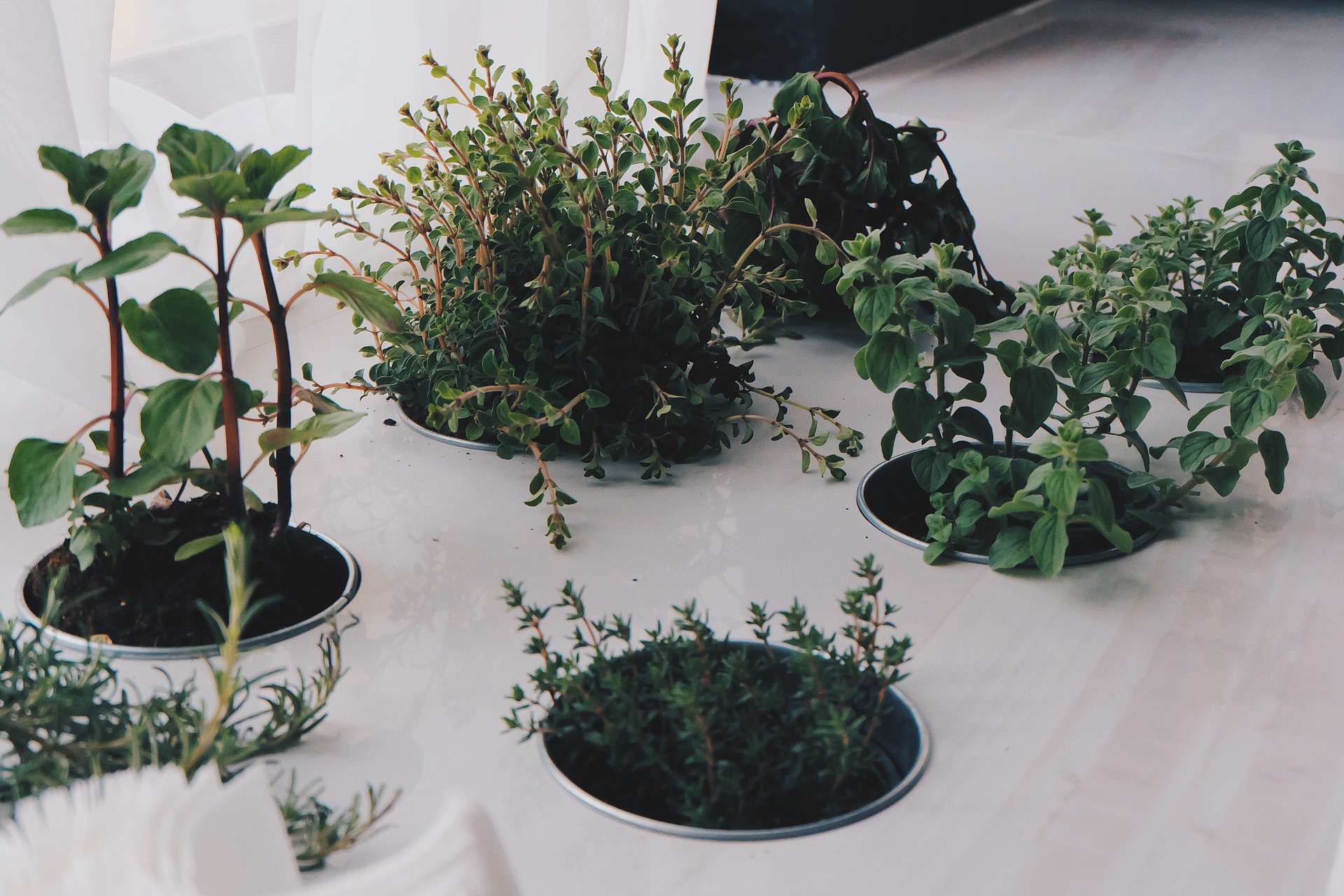Do you want to know what are the best spices to grow indoors? Do you love growing plants? Are you looking for ways to spice up your cooking? Growing spices indoors can be a great way to add flavor and variety to your meals. With just a few simple steps, you can have fresh herbs and spices right at your fingertips!
Growing herbs and spices indoors is also an enjoyable way to bring the outdoors in. It’s easier than ever before with small-space gardening techniques that allow even those without much outdoor space or natural sunlight access fresh flavors from the comfort of their homes. Plus, it’s fun!
So what are some of the best spices to grow indoors? And how do you get started?
The Best Spices To Grow Indoors: Guide To Growing Spices and Herbs
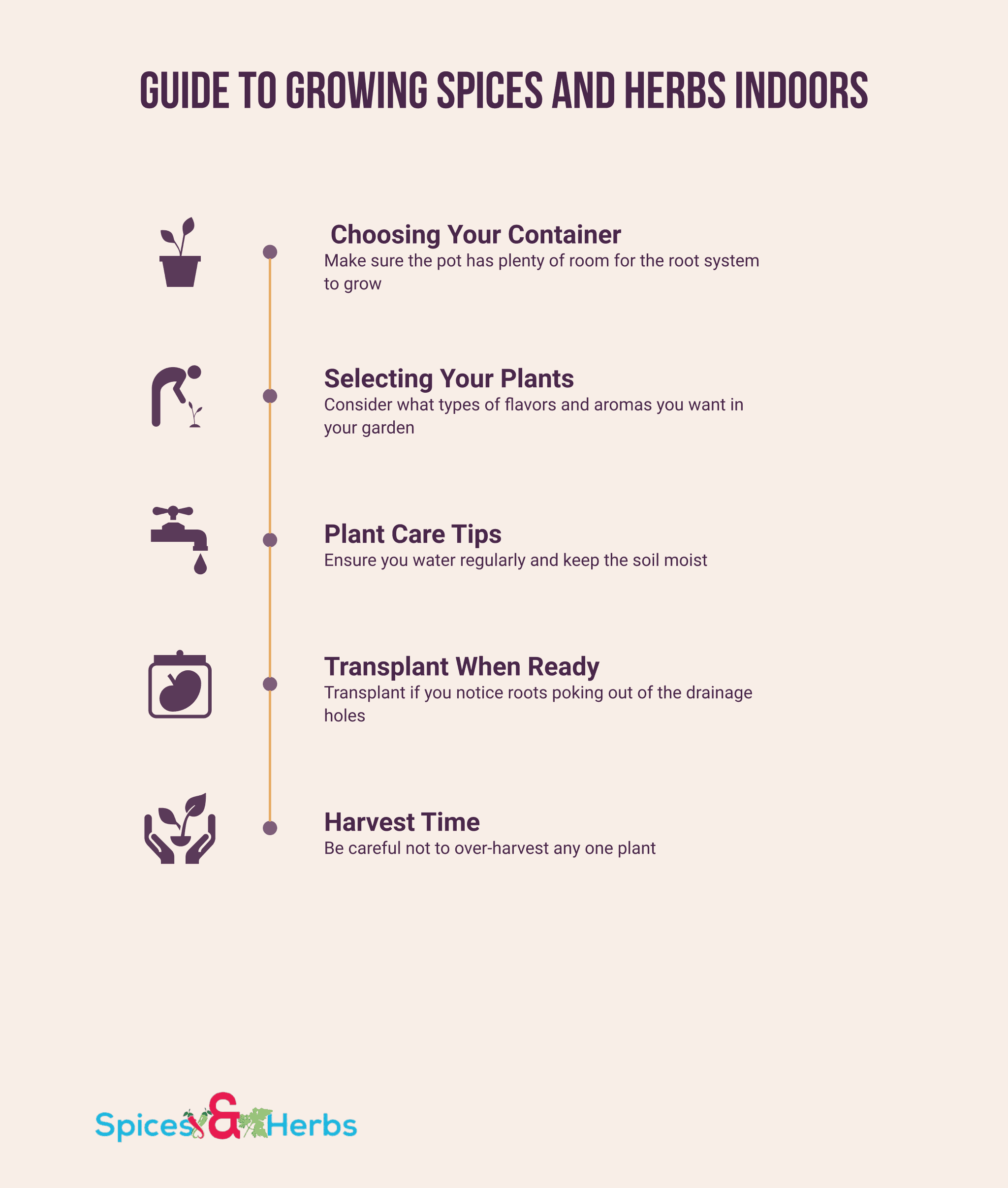
If you don’t have a lot of garden space or want to add a little green to your interior, growing herbs and spices indoors allows you to enjoy homegrown goods. For beginners, it can also be a low-risk introduction to more involved culinary gardening; all you require is a sunny window.
Also, it makes cooking at home simple—anytime you need fresh herbs, simply cut a few sprigs to add to a dish or use as a lovely garnish.
But even if you don’t have a green thumb, make sure you succeed by using these tried-and-true methods for your indoor herb and spice garden before you pot up your first plant.
🪴 Choosing Your Container
When it comes to selecting containers for indoor gardening, bigger is usually better. Make sure the pot has plenty of room for the root system to grow without overcrowding and enough capacity for adequate drainage.
Avoid using anything with harsh chemicals like pesticides or fungicides used on them in the past. Many gardeners have found success using wooden half-barrels, large pots, boxes, or even hanging baskets for their indoor gardens.
🪴 Selecting Your Plants
Next, determine which plants to buy for your indoor spice and herb garden. Consider what types of flavors and aromas you want in your garden before purchasing them at your local nursery or garden center.
You may also want to consider how much sun they need while growing indoors. Some plants require more sunlight than others. Be sure to research each plant’s needs carefully before making any purchases.
🪴 Plant Care Tips
Once your plants are in their containers, give them a good drink of water to properly settle in their new home! Going forward, ensure you water regularly (but don’t forget to overwater). Aim for keeping the soil moist but not soggy, as different plants have different water requirements (be mindful of this when mixing multiple types together!).
Make sure your space gets plenty of light as well. If unsure what type of light works best for your particular plant species, refer back to the label from your nursery or talk with an expert at the shop where you purchased them from!
🪴 Transplant When Ready
Herbal indoor plants don’t last forever. If you do it correctly, your herbs will ultimately exceed their containers and require more space, which is both good and bad news. It’s time to transplant if you notice roots poking out of the drainage holes, growth appears to have stopped, or the plant begins to flop over.
Perennial herbs like lavender and mint may typically be started indoors and planted outside once the risk of frost has gone. You can transplant annual herbs outside till the conclusion of the growing season.
Take cuttings before the first frost to restart the indoor herb garden procedure when colder weather arrives. You can either move the pots back inside or leave them outside when colder weather arrives.
You can transplant annuals and perennials into bigger pots inside your house at any time; just maintain them near a light source.
🪴 Harvest Time
Harvesting time is here! When harvesting herbs and spices, be careful not to over-harvest any one plant. Clip off only what you need so that it will keep producing new growth long after the harvest season ends!
There are many methods when harvesting herbs, such as plucking off leaves or pinching individual cloves off cloves of garlic. Whatever method works best for the herb and spice harvested should be adopted!
Try drying out different harvested herbs and spices by hanging them upside down in a warm area with good air circulation or using a dehydrator machine (which will require some extra investment).
And finally – have fun with it! Growing spices and herbs indoors can be an incredibly rewarding experience that allows you to explore different flavors while giving life to something else. Enjoy every step – from picking out plants at the nursery to tasting freshly prepared dishes made with ingredients grown right in your home!
Growing Herbs Indoors: The Best Spices To Grow Indoors
Are you ready to start growing spices indoors? Here are some of the best options:
🪴 The Best Spices To Grow Indoors: Chilies
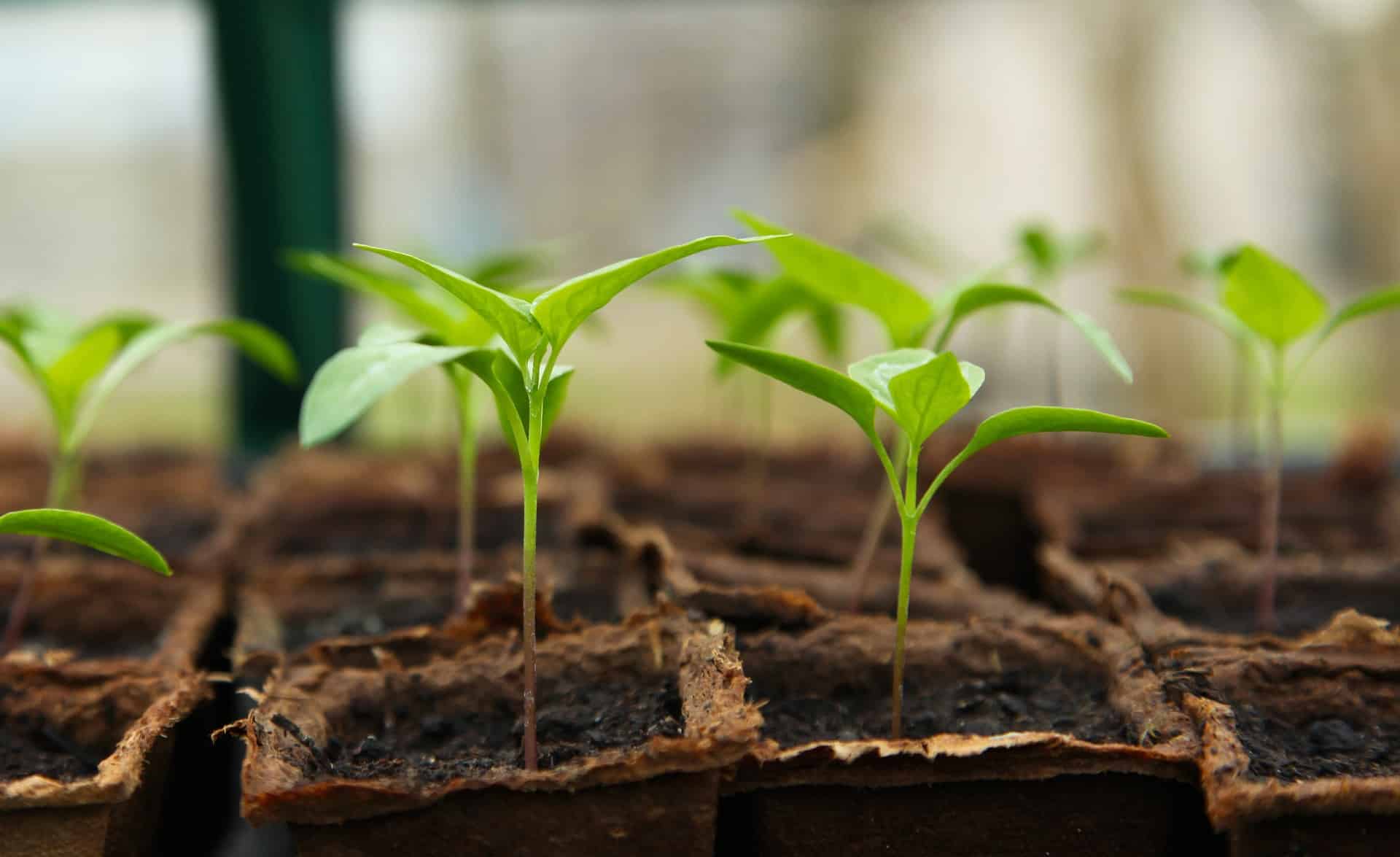
Chilies may be small, but they pack a punch when it comes to flavor. Whether you prefer spicy or mild dishes, there is a type of chili that will suit your taste buds. From jalapeño peppers to habaneros and beyond, unique varieties are abundant, just waiting to add interest and zest to your meals.
When growing these fiery little gems, you only need a sunny south-facing window and some good-quality soil. Make sure you select round pots that are at least 12 inches wide. This will give the roots plenty of space to spread as the plant matures. Chilies also love moisture, so make sure your pots are well-drained and water often!
Once your plants are established, you can start harvesting chili peppers anytime after ripening (usually takes 6-8 weeks). Simply twist off each pepper from the stem and store it in airtight containers or wrap them in cellophane paper for immediate use.
In addition to their delicious flavor, chili peppers can also confer numerous health benefits on those who consume them. They contain high levels of vitamins A and C and an array of antioxidants that help protect against disease-causing cells that form in our bodies over time. Furthermore, capsaicin – a powerful ingredient found exclusively in chili peppers – has been known to relieve pain by inducing endorphins that mask unpleasant sensations such as headaches or joint inflammation.
🪴 The Best Spices To Grow Indoors: Parsley
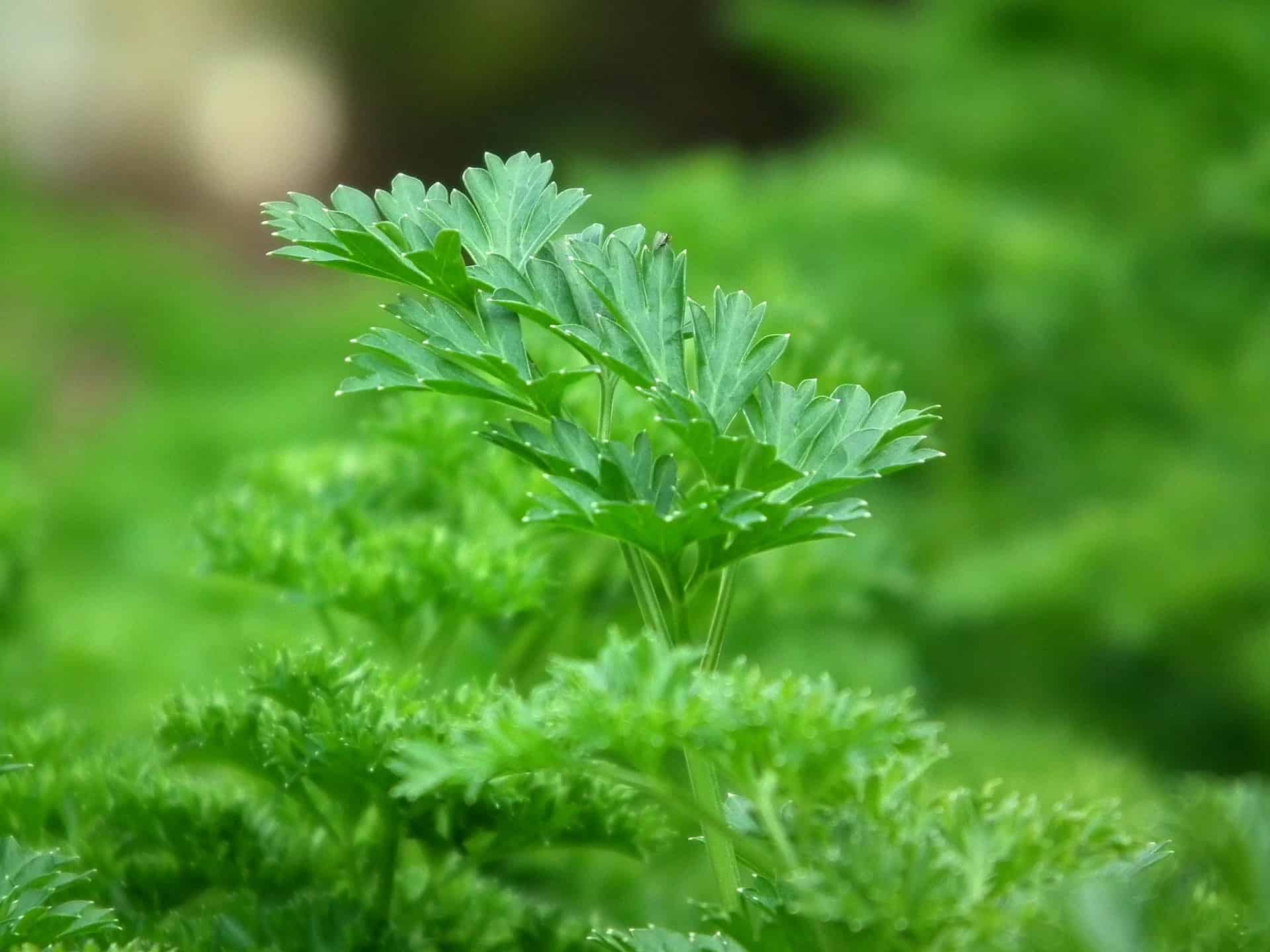
With its bright green leaves, parsley is both attractive and fragrant. Not only does it make an increasingly popular ingredient in salads and soups, but it’s also bursting with nutritional benefits. Studies show that parsley contains Vitamin C, carotenoids, and even flavonoids that can help boost overall immunity and reduce inflammation.
But how do you get started growing parsley indoors? First, let’s start with the essentials: seeds or transplants, soil mix, a pot with drainage holes, fertilizer (slow-release preferably), a spray bottle, and –most importantly – plenty of sunlight!
Once you have the supplies ready to go, choosing a spot that gets direct sunlight for four-six hours per day is important. Remember to fill the container with soil mix and water according to package instructions before planting seeds or transferring a transplant into the pot.
Fertilize your plant regularly every few weeks throughout its life cycle to ensure growth while watering just enough so that the top inch of soil is slightly moist. The amazing thing about this herb is that it grows faster than other plants. So, it should be ready for harvesting in no time!
🪴 The Best Spices To Grow Indoors: Chives
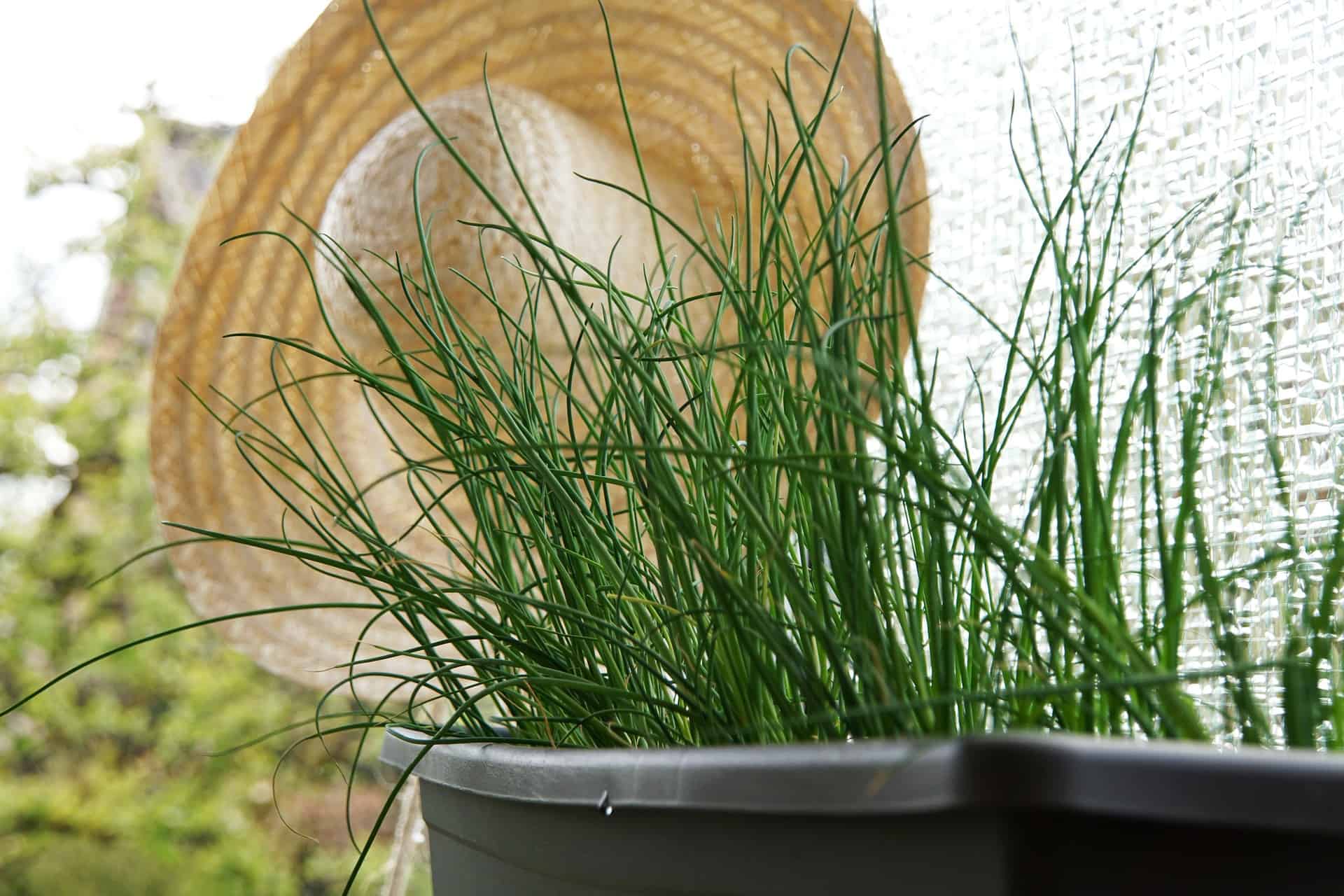
To grow chives indoors, purchase high-quality seeds from your local nursery or online store. While there are varieties of chives available, all require minimal maintenance. The most important thing is to ensure they get enough light (a sunny windowsill is ideal) and soil that retains moisture but doesn’t get waterlogged.
Watering is essential – especially during the hot summer when wide varieties quickly wilt if left too dry. In order to encourage new growth, it’s also recommended that you pinch off blooms as they appear. While they may look pretty, they drain energy from the leaves, so removing them consistently is better. Fertilizing once or twice per month is beneficial, too – anything organic should do the trick!
Growing chives indoors really is easy peasy. With some love and attention, you can have an ongoing supply of bright green leaves right in your kitchen! Whether used fresh in salads or cooked into something delicious like omelets or potatoes au gratin, this vibrant garden staple adds color and pizazz to any dish. So why not give it a go? It’s an affordable and rewarding way to expand your gardening skills at home!
🪴 The Best Spices To Grow Indoors: Oregano
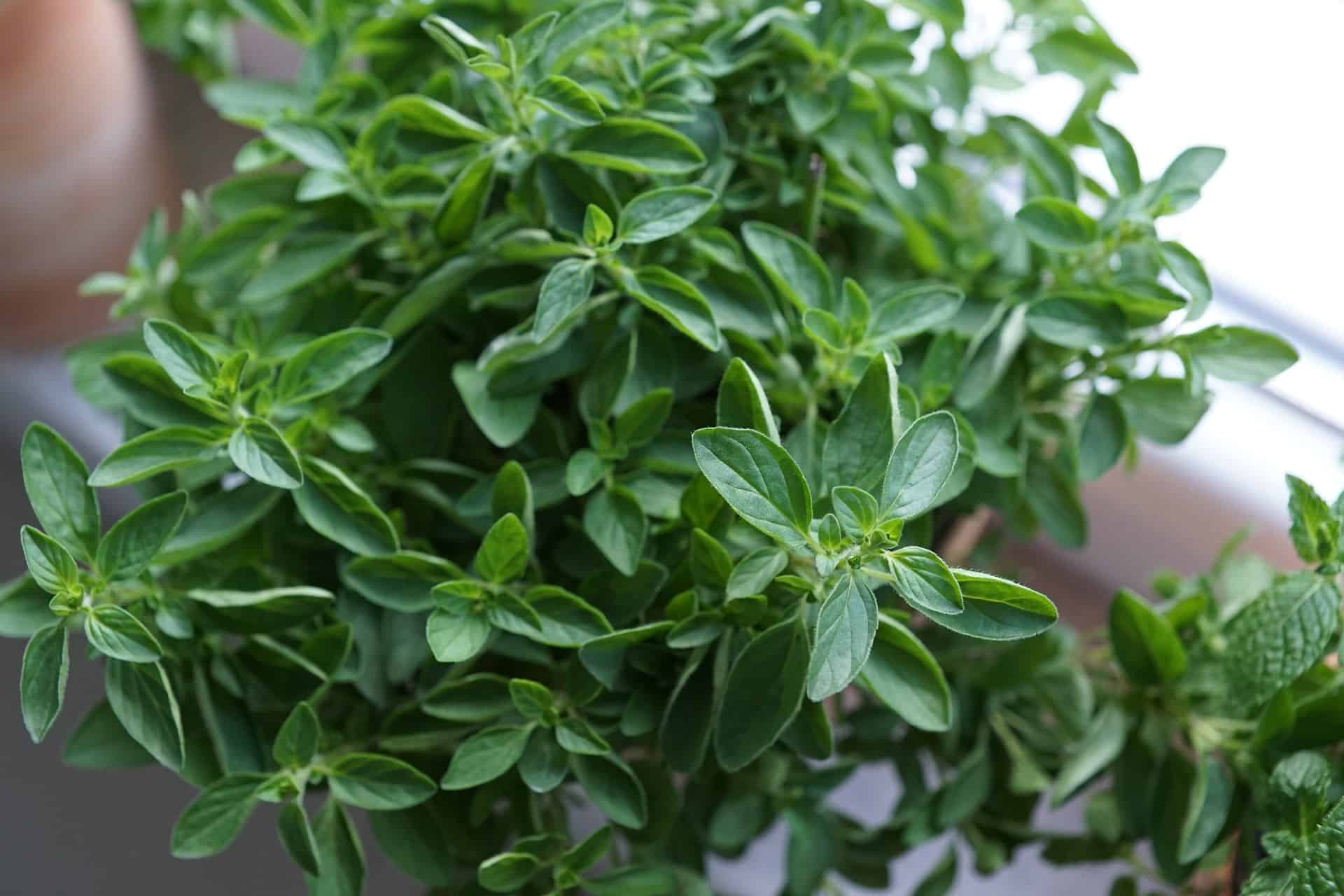
Oregano is a mint family herb with small green leaves with a distinctive smell and taste. This hardy perennial herb can flavor sauces, salads, soups, and bread. Plus, it’s highly fragrant and can even be a natural insect repellent!
When it comes to growing oregano indoors, the best time to start is in the late winter or early spring. The first step is selecting the right soil mix that’s well-draining, slightly acidic, and will work best for your indoor herb garden.
You’ll also need to ensure your pot has adequate drainage holes to escape any excess water. Planting oregano seeds is easy. Just sprinkle them on top of your soil mix and lightly cover them with more soil. For faster yields, you can also opt for starter plants instead of starting from seed.
It’s important to note that if you plan on consuming your oregano in any way (like cooking), ensure that any chemicals or fertilizers used are completely organic and safe for consumption! Keep an eye out for wilting or discolored leaves since this could mean underwatering or overwatering (or both). This low-maintenance herb does well when watered about once every few days – aim to keep the soil moist but not soggy at all times.
🪴 The Best Spices To Grow Indoors: Thyme
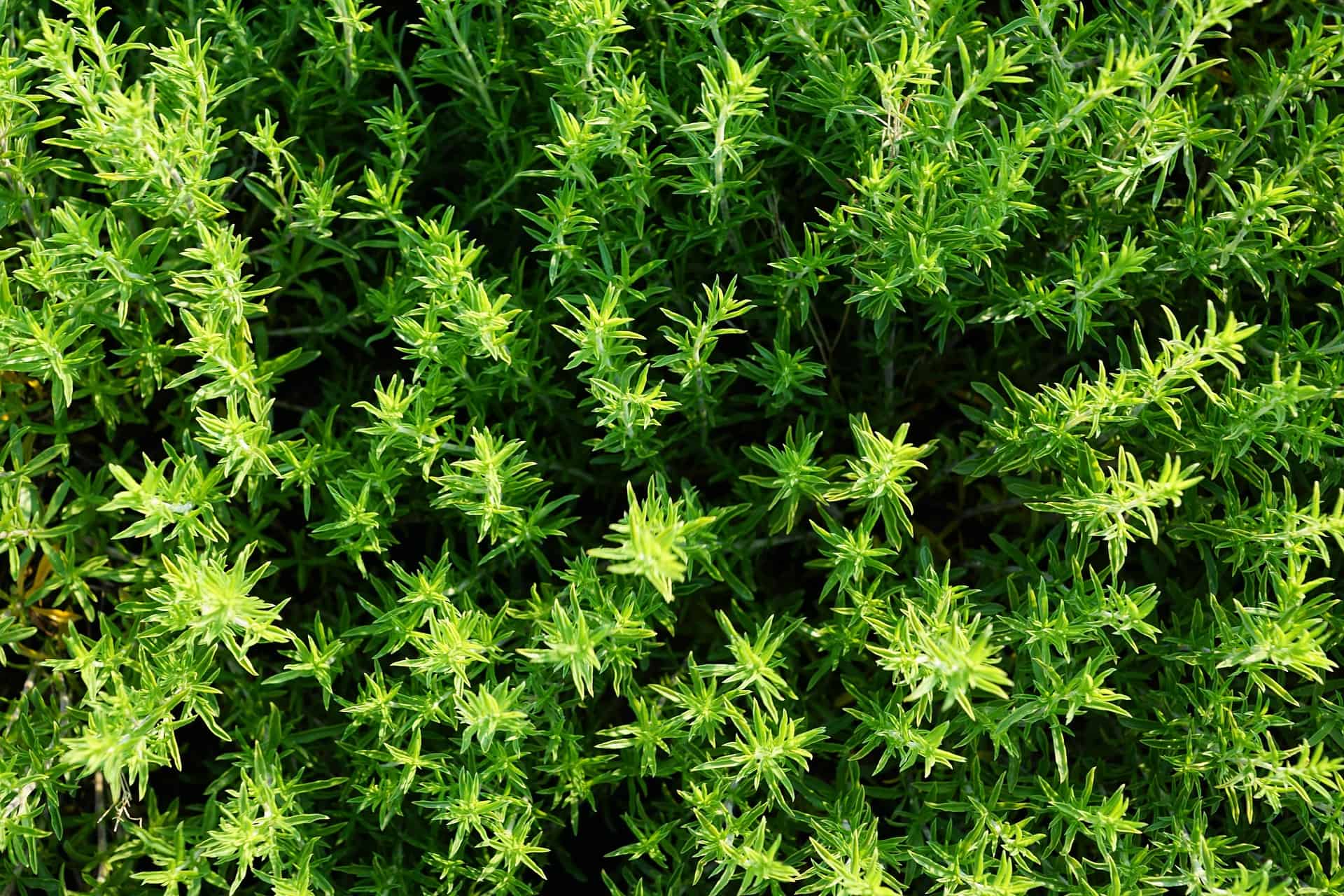
Thyme plant is a low-growing evergreen shrub with small leaves with a fragrant smell and a slightly lemony taste. It has been used in cooking for centuries. The Romans even believed it had magical properties! In modern times, it’s still widely used in many classic dishes like roasts and stews and works especially well with vegetables like potatoes and mushrooms.
First of all, you need to find an appropriate container for your plants – something deep enough so the roots can spread out and wide enough. Therefore, each stem gets adequate light exposure. Then, regularly fill your pot with pre-fertilized soil and water once the top inch or two dries out.
Finally, place your plant in front of a sunny windowsill herb garden. Ideally south-facing – and watch it thrive! Once your thyme has grown enough (usually after 3-4 weeks), you can harvest its fragrant leaves.
Simply twist off individual stems until you get the desired amount – normally 2-3 tablespoons. Then discard the stem afterward. Alternatively, if you want to keep your thyme fresh longer, either freeze or dry them before using them in recipes.
🪴 The Best Spices To Grow Indoors: Lemon Balm
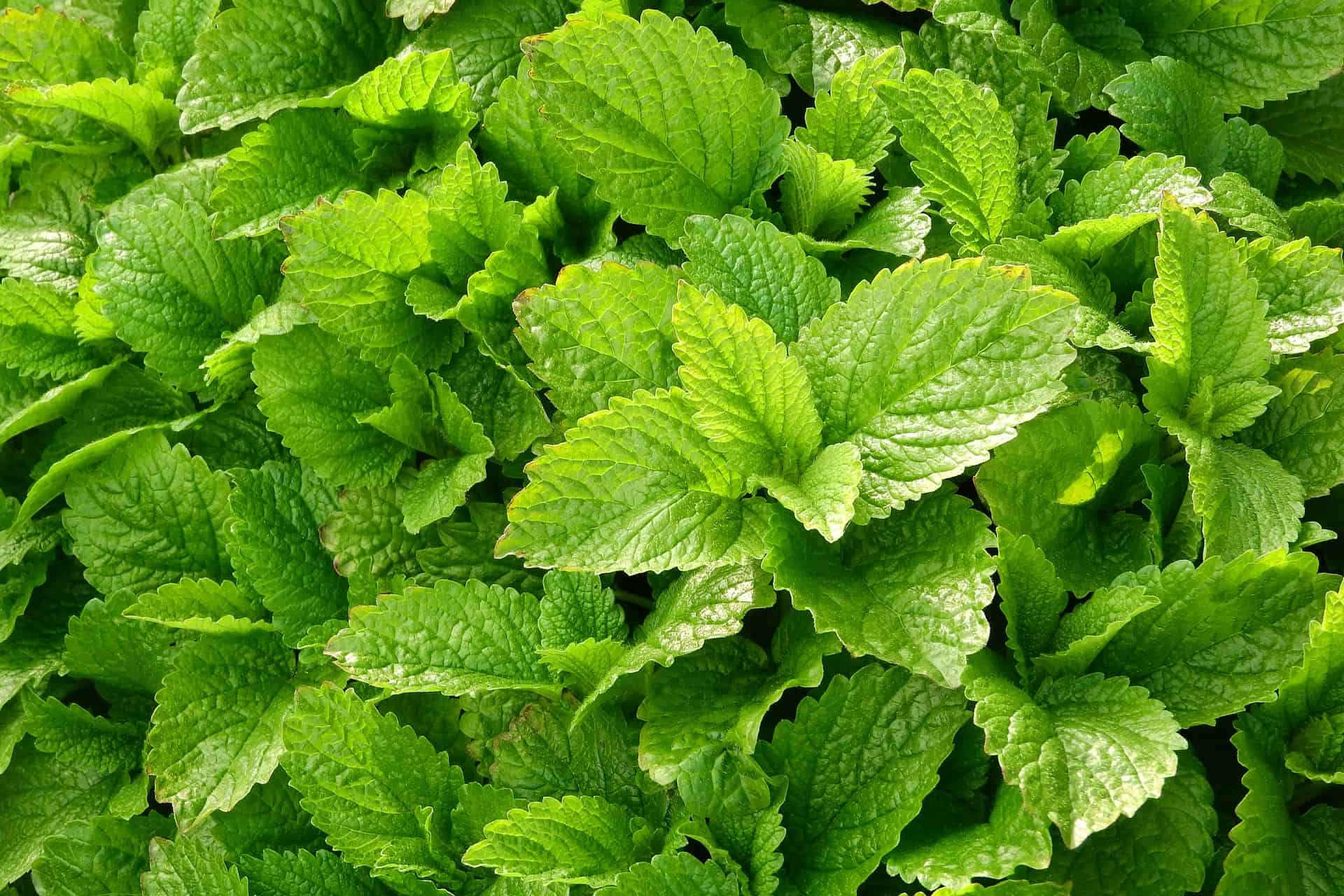
Lemon balm is a herb that belongs to the mint family. Its leaves feature an intense, citrusy aroma and flavor. Fresh or dried leaves are added to salads, sauces, teas, soups, and other sweet dishes. The herb has even been known to be steeped in wine!
The good news is that you only need a little space to grow lemon balm indoors. They grow quite well in containers like pots or window boxes. To get started:
- Place your pot in direct sunlight near a window and fill it with soil amended with perlite or peat moss for better drainage.
- Place as many seeds as desired on top of the soil surface. Then, lightly cover with more soil (1/4 inch should suffice).
- Carefully water the pot until damp but not soaked for best results.
Remember that lemon balm spreads out quite quickly when planting multiple plants together in one pot. Therefore, provide enough space between them when planting (around 6-12 inches should do it).
Also, note that some varieties are especially vigorous growers so plan accordingly! Depending on your climate conditions, you should begin seeing sprouts within two weeks after planting.
🪴 The Best Spices To Grow Indoors: Basil
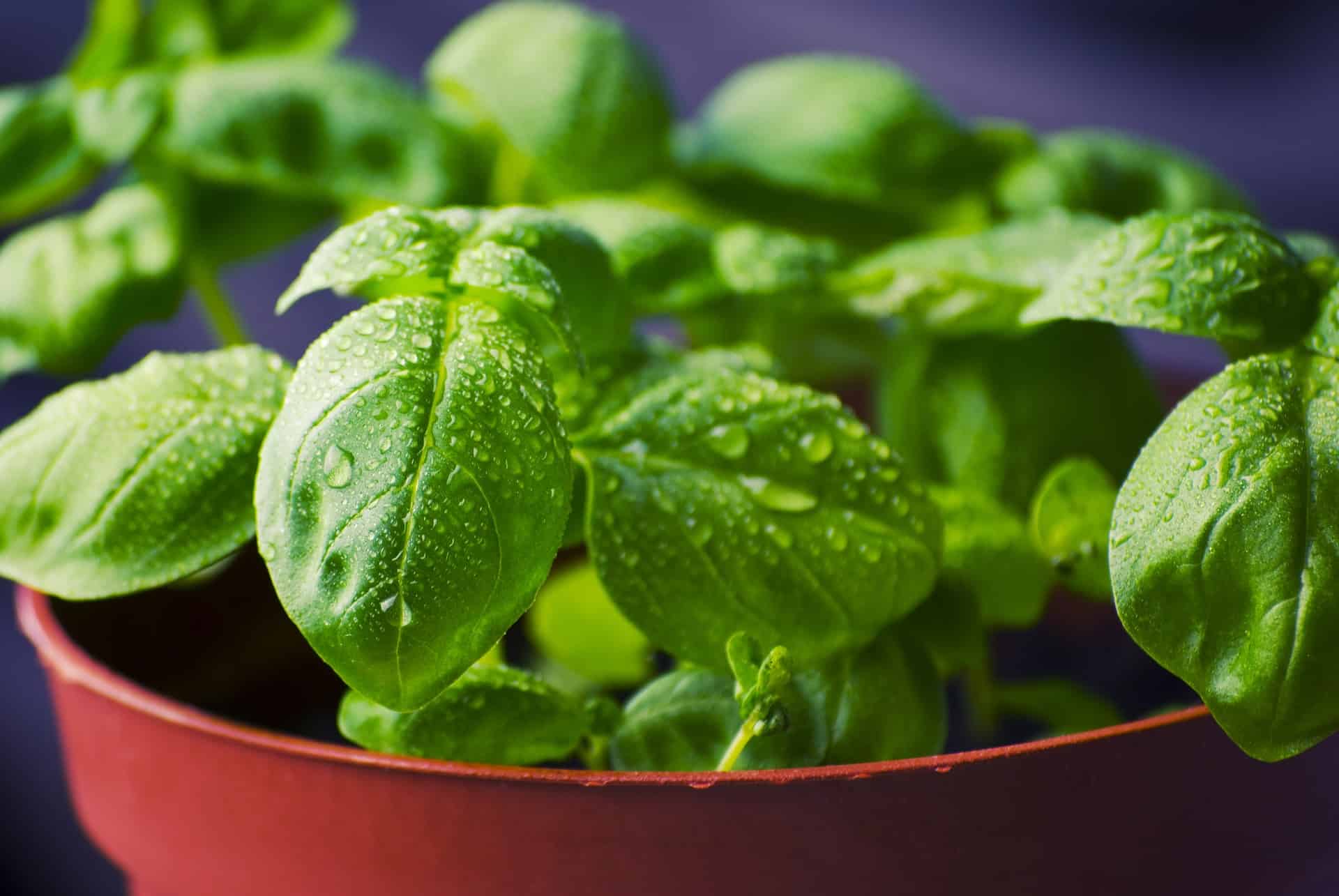
Have you heard of basil? This growing herb is a favorite among many home cooks, and for a good reason. Not only does it add flavor to your dishes, but it can be easily grown indoors for a fresh supply all year round.
Basil is an aromatic annual herb that is part of the mint family. Its leaves have a sweet yet slightly peppery taste with some notes of aniseed. The plant was originally from India but is now widely cultivated in many parts of the world. It thrives in warm climates and can survive mild winters.
Growing basil indoors is easy, provided you give it the right environment and proper care. All you need is a container, soil, drainage holes, fertilizer, and plenty of sunlight to get started! Here are some tips on how to grow indoor basil:
- Place your pot or container near a window that gets at least six hours of direct sunlight per day (south-facing works best).
- Choose a well-draining potting mix that’s specifically designed for herbs.
- Water your basil regularly but avoid overwatering as this can cause root rot. Depending on temperatures and the pot size, they only need about 1″ (2 cm) every week.
- Fertilize twice a month with a liquid houseplant fertilizer or compost tea.
- Prune frequently to encourage bush growth and prevent flowering if you don’t want seeds to form. Pruning also encourages more leaves to grow!
Once your Basil plants are mature, they’ll be ready for harvest! The best time to harvest basil is when its leaves are still quite young because older leaves tend to become tough and bitter.
So, pick them often before they flower and go to seed. You can use basil in salads, pasta, soups, or even just garnish! Lastly, enjoy your delicious homegrown basil by eating it or adding it to any dish you like!
🪴 The Best Spices To Grow Indoors: Lemongrass
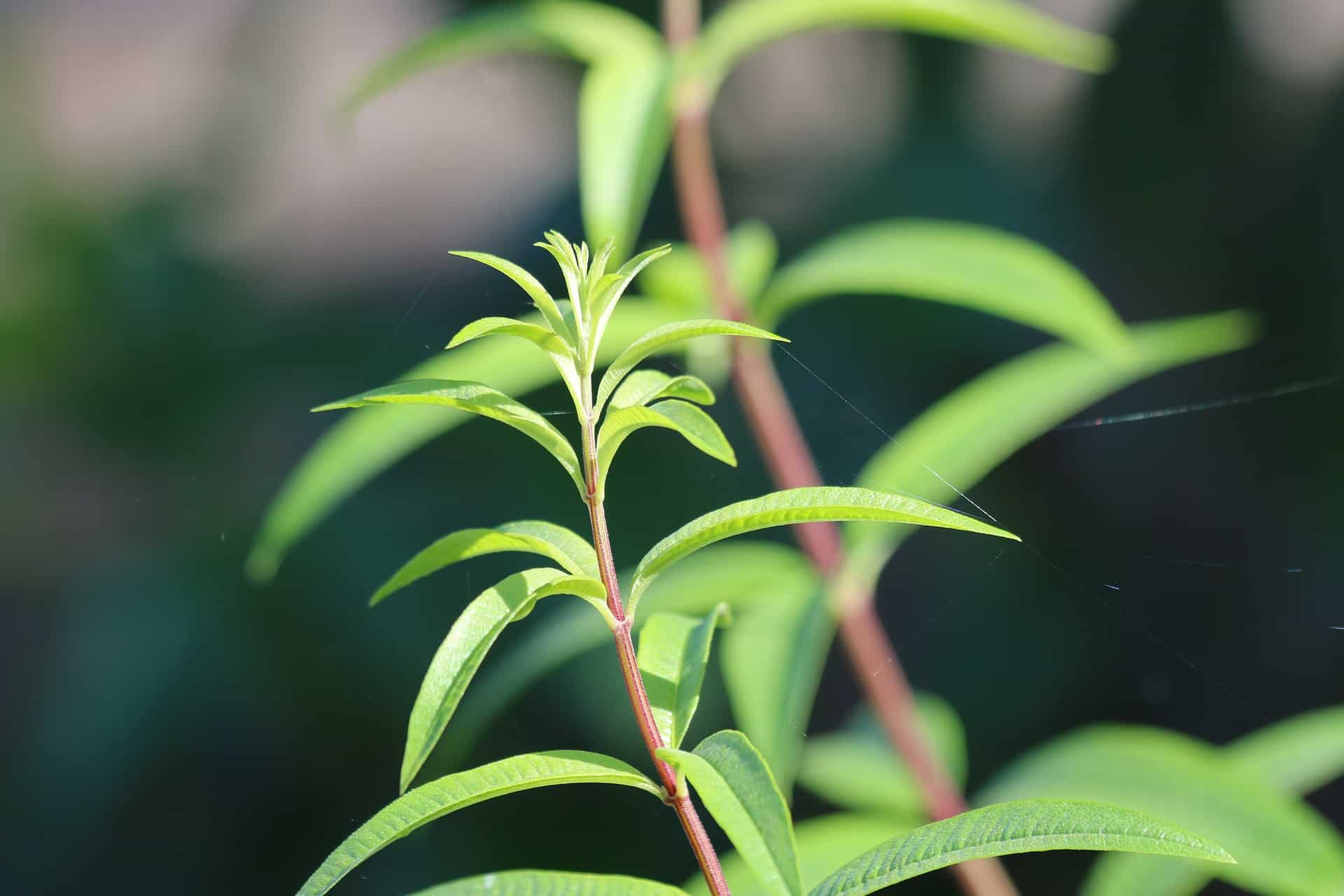
Lemongrass is a type of grass native to South Asia, India, and Sri Lanka. It has thin green stalks that are highly fragrant – they smell like lemon! – hence its name. It’s typically used as an herb or seasoning in Asian cuisine and is especially popular in Thai cooking.
Lemongrass adds a unique flavor and aroma to many different dishes. Try adding it to soups (especially those with coconut milk), curries, stir-fried dishes, and even salads. For extra flavor, you can also steep the stalks in hot water along with other herbs or spices like ginger or cinnamon. The possibilities are endless!
Growing lemongrass indoors is surprisingly simple – all you need is a potting mix, some soil, and some seeds or starters from your local nursery. Place the seeds about one inch deep into the soil and keep them moist for several weeks until the plants start to sprout.
Keep the plants near a window with plenty of sunlight during the day, ensuring they receive at least 8 hours of direct light each day. After this, fertilize them regularly using fertilizer specially made for grasses, water them twice weekly, and voila – you have homegrown lemongrass!
Indoor Herb Gardens Ideas That Don’t Need a Windowsill
If you don’t have a windowsill or space near a window, you can still have an herb garden indoors! Here are some creative ideas for indoor gardens that don’t need a windowsill:
✅ Hanging Planters
Hanging planters allow you to add lovely greenery and herbs to any room in no time. They also come in all shapes, sizes, and colors, so there’s something out there for everyone. Hang your planters near a window and make sure your herbs get six hours of direct sunlight per day for the best results.
✅ Hydroponic Herb Garden
Hydroponics is another great option that doesn’t require any type of soil. The water-based system keeps your plants supplied with the right amount of nutrition while allowing you to control various parameters, including temperature and light exposure.
Hydroponic systems are relatively easy to set up and can be used in any space – even a closet! Plus, they take up much less space than traditional potted plants but can still provide an abundance of tasty herbs like basil, chives, mint, and more.
✅ Mason Jars
Mason jars are one of the simplest ways to create a charming indoor herb garden that won’t take up too much space or require special equipment or extra maintenance. Simply fill each jar with soil and add your chosen herbs. Make sure their roots fit comfortably inside the jar, and their leaves will be allowed enough room outside for growth. Then, hang them wherever convenient and watch as they flourish!
For extra convenience, try using mason jars with drainage holes already included on the bottom. Therefore, you won’t need to worry about overwatering, which can be especially harmful indoors, where oxygen levels are typically lower than outdoors.
✅ Vertical Wall Garden
Vertical wall gardens present an interesting alternative if you want something more modern looking than hanging planters but need more space for a large hydroponic system too. Constructed from lightweight containers such as fabric pockets or trellis boxes, you can easily mount these fantastic hanging gardens onto walls or other flat surfaces like furniture pieces, adding beautiful visual interest while providing plenty of fresh herbs whenever needed!
Just remember that since these wall gardens take up little surface area. Ensure your chosen plants will receive enough indirect sunlight throughout the day to thrive correctly. Most culinary herbs do best when given four to six hours daily from natural light sources like window sills or fluorescent lamps (if necessary).
Frequently Asked Questions
Q: What are the easiest herbs to grow indoors?
Some of the easiest herbs to grow indoors are Mint, Basil, and Thyme! While each of these herbs has different preferences for sunlight, water, and soil pH levels, all are relatively easy to maintain indoors with enough natural or artificial light. Plus, you’ll be gifted with tasty fresh herbs year-round when you grow them indoors! With minimal effort and care, you can enjoy the freshest dishes without stepping outside your door.
Q: Does the potting soil need to be changed for indoor herbs?
This will depend on your home’s conditions and the kind of herbs being grown. Consider replacing the potting soil once a year if you’re growing annuals like parsley or basil so that your herbs can access new nutrients. Some more hardy herbs may not require soil replacement every year. It will probably prosper without a complete soil change if the soil is kept well-draining and fertilized with liquid fertilizer each week.
Q: What is the best way to harvest fresh herb leaves?
The best way to harvest herb leaves is to avoid taking too many. Picking off a few leaves from each stem over time will ensure that you always have plenty of fragrant and flavourful herbs. Take care not to pull off entire stems. Moreover, try harvesting when the weather’s dry. Ensure you don’t carry any moisture from sprinklers or rain into your kitchen when using your freshly-cut herbs.
Q: Why do herb plants need indirect sunlight?
Plants need sunlight to survive, but it can be tricky to find the right balance. Too much direct sunlight can damage delicate herb plants. Therefore, providing your herbs with indirect sunlight is important if you want them to thrive. To do this, you could position them in an area where they will still receive plenty of natural daylight without being exposed to the strongest heat of the sun’s rays. Maybe keep them towards the back of a windowsill or near a skylight that provides a more softened light. This way, your fragile herbs won’t be negatively impacted. Plus, it will have enough sunshine for their leaves and roots to soak up what they need!
Q: Are there any special methods for watering indoor herb plants?
When it comes to indoor herb plants, it’s important to give them the right amount of water to thrive! While there isn’t a single “right” way to water an indoor herb plant, some good tips and tricks will help you keep your herbs well-hydrated. For instance, depending on the humidity in your home and the type of soil you’re using, you’ll want to adjust how much water you’re giving your plants. Additionally, overhead watering is typically not recommended for herbs since it can make the leaves soggy and cause mildew. The best rule of thumb is to feel the soil as you go. If it’s dry several inches below surface level, give your plant a deep but slow watering with room temperature water until moist. Then wait until the top layers have started drying before watering again!
Final Words
Growing herbs and spices indoors can be really rewarding, giving you plentiful flavors for when you’re cooking and lots of greenery to enjoy. Parsley, cilantro, basil, chives, and chilies are all great options that grow neatly in containers and thrive on a sunny windowsill. For spice lovers who prefer not to grow their own plants, there are plenty of dried versions to use, too. But look out for organic if possible (that way, you know exactly what’s gone into the pot!). So whichever way you prefer to add flavor to your dishes, herbs and spices present an exciting range of options. Enjoy experimenting with recipes and getting creative – cooking has never been so fun!

